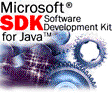|
|
| |

|
|
|||||||||||||||
|
Microsoft's Application Foundation Classes (AFC) are a comprehensive set of Java class libraries providing user interface controls, graphics and effects classes and the ability to create and extract cabinet (CAB) files. AFC's UI controls give Java developers a rich set of UI elements from which they can quickly build flexible, modern and powerful user interfaces for their applications, enhanced by the innovative graphics techniques exposed for the first time by the Fx graphics and effects classes. Developers can, through the Java CAB APIs, utilize Microsoft's CAB packaging and compression technology on any virtual machine. Written in Java, AFC ensures that applications built using these classes run on the most popular platforms supporting Java. The AFC UI controls are defaulted to the Windows UI, and are also are fully customizable to reflect the needs of application and applet designers. AFC supports Active Accessibility for Java, so any application developed using AFC is automatically accessibility-enabled. AFC comprises:
Known Issues for AFC
In addition, Microsoft will be shipping the redistributable components of AFC as AFC102.ZIP shortly after its SDK 2.0 for Java. AFC102.ZIP will contain a version of AFC that is fully JDK 1.02-compatible, and has been tested on popular JDK 1.02-compatible browsers on Win32 and other platforms. A license agreement provided with AFC102.ZIP will give full licensing and redistribution details, and any differences affecting developers between the 1.02 and 1.1 versions of AFC will be described in accompanying documentation. Watch http://www.microsoft.com/java/sdk for the latest details.
Please note: As AwtUI and UIAwt objects are intended only to provide a bridge between AWT and AFC, use of AwtUI and UIAwt should be confined to situations where a bridge is necessary and beyond this should be limited to prevent performance degradation and to permit the full benefits of AFC to be realized. AFC's API documentation and articles on http://www.microsoft.com/java/ give further implementation details.
|
| © 1997 Microsoft Corporation. All rights reserved. Terms of use. |